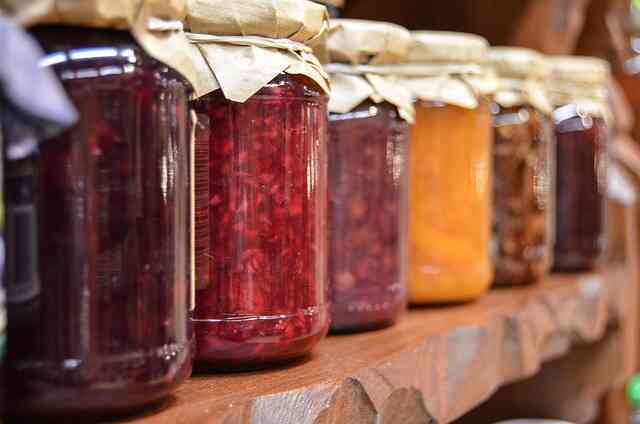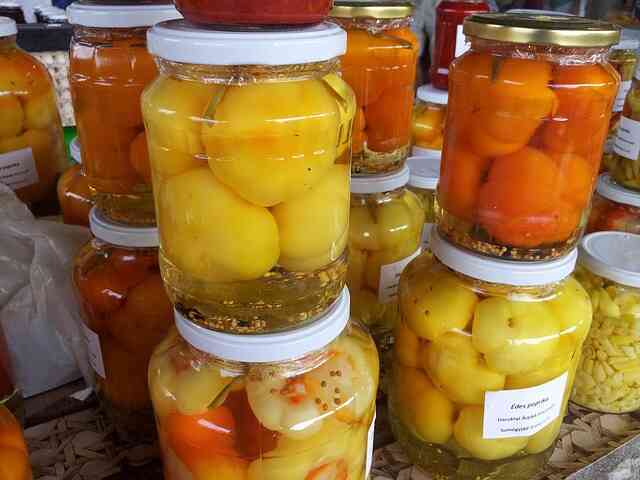
Table of Contents
In our modern world, preserved food items have become an inseparable part of our daily diet. Whether it’s canned fruits, pickles, frozen vegetables, ready-to-eat meals, or packaged snacks, preserved foods offer convenience, longer shelf life, and often better accessibility, especially in urban areas. But a common question lingers in the minds of health-conscious individuals: Are preserved food items good or bad for our health?
In this article we explores preserved foods in depth—explaining what they are, how they’re preserved, the benefits they offer, the potential health risks, and how to make smarter choices while including them in your diet.
What Are Preserved Food Items?
Preserved food items are foods that have undergone a process designed to prevent spoilage and extend their shelf life. The primary goal of food preservation is to keep food safe to eat over a longer period while maintaining as much of its original taste, texture, and nutritional value as possible.
In simple terms, preservation is the technique of slowing down the natural decay of food caused by microorganisms (like bacteria, molds, and yeasts), enzymes, or exposure to oxygen and moisture. Without preservation, many foods—especially fresh fruits, vegetables, meat, and dairy—would spoil in just a few days.
But to truly understand what preserved foods are, we need to go beyond just the definition and look at the types, techniques, historical background, and common examples.
The Science Behind Food Spoilage
Before exploring preserved food, it’s helpful to understand why food spoils in the first place.
- Microorganisms: These are bacteria, yeasts, and molds that grow on food and cause it to rot or become unsafe to eat.
- Enzymes: Natural enzymes present in food speed up ripening and can continue breaking down food even after it’s harvested.
- Oxidation: Oxygen in the air reacts with food components, leading to discoloration, rancid flavors (especially in fats), and nutrient loss.
- Moisture: High moisture levels in food encourage microbial growth and decay.
Preservation methods are designed to control one or more of these factors, either by removing water, lowering temperature, killing microbes, or blocking oxygen.
Historical Roots of Food Preservation
Preserving food is not a modern invention. Ancient civilizations developed clever ways to keep food from spoiling long before the refrigerator or freezer was invented.
- Sun drying was used in ancient Egypt to preserve fish and fruits.
- Salting and smoking were common in early Europe and Asia to preserve meat and fish.
- Fermentation was used by many cultures to make yogurt, cheese, pickles, and alcohol.
- Honey and vinegar were used to preserve fruits.
Today, food preservation has advanced with science and technology, leading to many more methods and commercially available options.
Why Preservation is Important in Modern Life
Preserved foods play a critical role in today’s food system:
- Supports busy lifestyles with quick meal options.
- Prevents food shortages in areas with poor infrastructure.
- Reduces food waste by extending shelf life.
- Provides access to seasonal or exotic items year-round.
- Ensures food safety during emergencies or natural disasters.
Are Preserved Foods Always Unhealthy?

Not necessarily. Preservation itself is not harmful—it’s the method and ingredients added that determine whether the final product is healthy or not.
- Frozen carrots are almost as good as fresh ones.
- Canned beans (low sodium) are rich in protein and fiber.
- Dried fruits provide iron and energy (if no sugar added).
On the other hand:
- Packaged snacks and processed meats with excessive salt, sugar, or unhealthy fats can increase the risk of heart disease, diabetes, and obesity.
Why Are Preserved Foods So Popular?
Preserved foods are not just popular; they are essential in many parts of the world. Here’s why:
- Convenience:
Preparing fresh meals daily can be time-consuming. Preserved foods reduce prep time significantly. For busy families or working individuals, ready-to-eat or frozen items are lifesavers.
2.Long Shelf Life:
Fresh food can spoil in a few days. Preserved items stay good for weeks or even months, reducing food wastage.
3.Availability:
Seasonal fruits and vegetables are not always available fresh. Thanks to preservation, items like berries, mangoes, and green peas can be consumed year-round
4.Affordability:
Preserved foods are often cheaper than fresh foods, especially in off-seasons.
5.Food Security:
Preserved foods help during natural disasters, pandemics, and times when supply chains are disrupted.
Benefits of Preserved Food Items
1. Reduced Waste and Better Food Security
Food spoilage is a huge global issue. Preservation extends the usability of food items, allowing distribution over long distances and preventing wastage.
2. Nutrient Retention (in Some Methods)
Freezing and drying preserve most nutrients when done correctly. For instance, frozen peas may have more vitamin C than peas sitting for days in a fridge.
3. Economic Advantages
Preserved items reduce the cost of logistics, storage, and distribution. They are mass-produced, packaged, and can be sold at lower prices, making them more accessible to low-income populations.
4. Availability in Remote Areas
Preserved foods make it possible for remote or rural communities to access foods that are not grown locally.
5. Enhanced Food Safety (in Certain Forms)
Canning and vacuum sealing can prevent microbial growth, making food safe for longer durations if properly stored.
Risks and Downsides of Preserved Foods
Despite the advantages, preserved foods come with significant concerns that can’t be ignored.
1. Nutritional Loss
Some preservation methods lead to a reduction in essential vitamins and minerals. Heat used in canning can destroy vitamin C, B vitamins, and antioxidants.
2. High Levels of Sugar, Salt, and Fats
To enhance taste and preserve food, manufacturers often add large amounts of sugar, sodium (salt), and unhealthy fats. Excess intake of these can lead to:
- Hypertension
- Heart disease
- Diabetes
- Obesity
For example, canned soups and pickles can contain over 1000mg of sodium per serving—nearly half the daily recommended intake.
3. Use of Harmful Preservatives
Some artificial preservatives like sodium nitrate (used in processed meats) have been linked to an increased risk of cancer. Others, like MSG, may cause headaches or allergic reactions in sensitive individuals.
4. Chemical Contamination
Canned foods sometimes come with a risk of contamination from the lining of cans, which may contain BPA (Bisphenol A). This chemical is associated with hormone disruption and increased risk of certain cancers.
5. Addiction to Processed Taste
People who frequently eat preserved or processed foods may develop a preference for their strong flavors, reducing their liking for natural, fresh, and less seasoned foods.
How to Make Smarter Choices with Preserved Foods
Here are some practical tips to help you balance convenience with health:
- Read the Label:
Always check for added sugar, sodium, unhealthy fats, and artificial preservatives. Go for items marked “low sodium,” “no added sugar,” or “preservative-free.” - Choose Freezing Over Canning:
If possible, go for frozen rather than canned vegetables or fruits. Freezing retains more nutrients and usually requires fewer additives. - Rinse Canned Foods:
Draining and rinsing canned beans or vegetables can significantly reduce the sodium content.
4.Practice Moderation:
Preserved foods can be part of a balanced diet, but they should not replace fresh fruits, vegetables, and whole foods entirely.
5.Make Homemade Preserved Foods:
Preparing your own jams, pickles, or dried fruits at home allows you to control ingredients, avoid chemicals, and adjust salt/sugar to healthy levels.
Cultural and Traditional Importance of Preserved Foods
Across centuries and continents, preservation has not just been about safety—it has become a part of cultural identity and culinary tradition.
India
- Pickles (Achar): Made using mustard oil, salt, and spices; pickling is deeply rooted in Indian households and varies from region to region—like mango pickle in the North or lime pickle in the South.
- Papad and Fryums: Sun-dried items made from lentil or potato flour, often preserved for months and enjoyed as side snacks.
- Dried Fish and Spices: Coastal regions preserve seafood using sun drying and salting.

Korea
Kimchi: Fermented cabbage with chili, garlic, and ginger. It’s not just a food item but a national dish and cultural symbol, full of probiotics.
Europe
- Cured meats: Prosciutto, salami, and sausages are examples of salted and aged meats from Italy, Spain, and Germany.
- Cheese and Wine: Fermented and aged, they are both examples of how preservation has created gourmet food categories.
Japan
- Miso and Soy Sauce: Fermented soy products that are shelf-stable and central to Japanese cuisine.
- Tsukemono: Japanese pickled vegetables served with almost every meal.
These traditional methods were often healthier, used natural ingredients, and were passed down through generations. Understanding them also helps us appreciate the historical wisdom behind preservation without chemicals or artificial additives.
Environmental Impact of Preserved Foods
Food preservation also impacts the environment—both positively and negatively.
Positive Aspects:
- Reduces Food Waste: Preservation prevents spoilage, allowing food to be transported long distances and stored longer, reducing global food waste significantly.
- Minimizes Resource Usage: By extending shelf life, fewer resources (like water, fuel, labor) are wasted producing replacement food.
- Supports Sustainability: Preserved plant-based items like dried legumes or canned vegetables are more sustainable than fresh meat in terms of water and carbon footprint.
Negative Aspects:
- Packaging Waste: Many preserved foods come in plastic, cans, or foil that contribute to landfills and pollution.
- Energy Consumption: Industrial preservation (like deep freezing or processing) uses large amounts of electricity.
- Chemical Pollution: Preservatives and additives used in food can eventually make their way into water bodies and soil through waste disposal, harming ecosystems.
The takeaway: not all preservation methods are eco-friendly. Opting for glass containers, bulk items, and natural preservation helps reduce the ecological footprint.
Economic Impact of Preserved Foods
Preserved foods form a major part of the global food economy. Their economic influence is seen across production, distribution, retail, and household savings.
1. Mass Production and Affordability
Preserved foods are cheaper to produce and transport in bulk. This lowers food costs for consumers, especially in low- and middle-income countries.
2. Food Industry Growth
Industries that produce frozen, canned, and packaged food contribute billions to the economy. These also generate employment across agriculture, manufacturing, packaging, and logistics.
3. Household Budgeting
Preserved staples like rice, lentils, frozen vegetables, or dried spices help families manage food budgets efficiently and avoid frequent trips to the market.
However, over-dependence on industrialized preserved food can harm local fresh markets, small farmers, and traditional food systems.
Conclusion: Good or Bad – It Depends
Preserved foods are not inherently “bad.” They range from minimally processed items like frozen vegetables to highly processed ones like instant noodles. While excessive reliance on heavily processed, additive-laden preserved food can harm your health, smart choices, moderation, and label awareness can help you enjoy their convenience without major risks.
Ultimately, the goal is balance. Use preserved foods to complement a diet rich in fresh, whole, and natural items. If you are mindful of what you’re eating and how often you’re eating it, preserved foods can be a useful, safe, and even nutritious part of your lifestyle.
Pingback: Foods That Naturally Detox Body know easy tips to detox 10
Pingback: Foods That Naturally Detox Body know The Best TipEasy Way